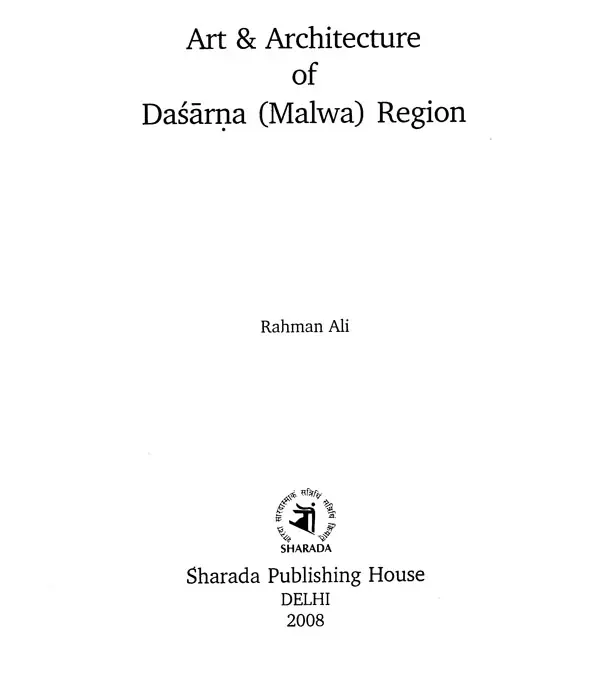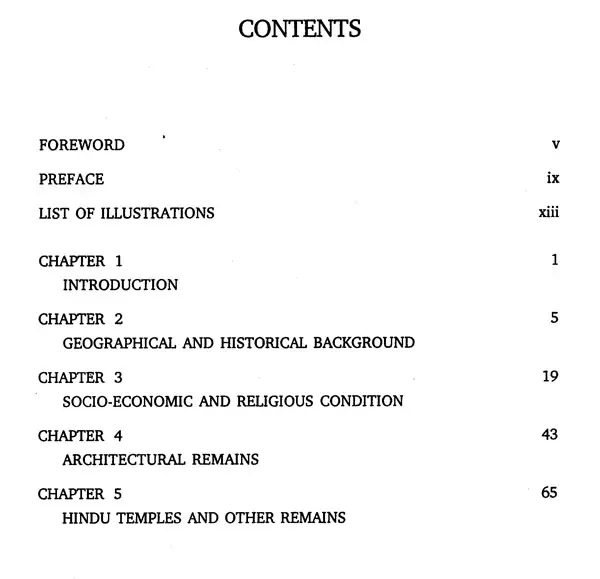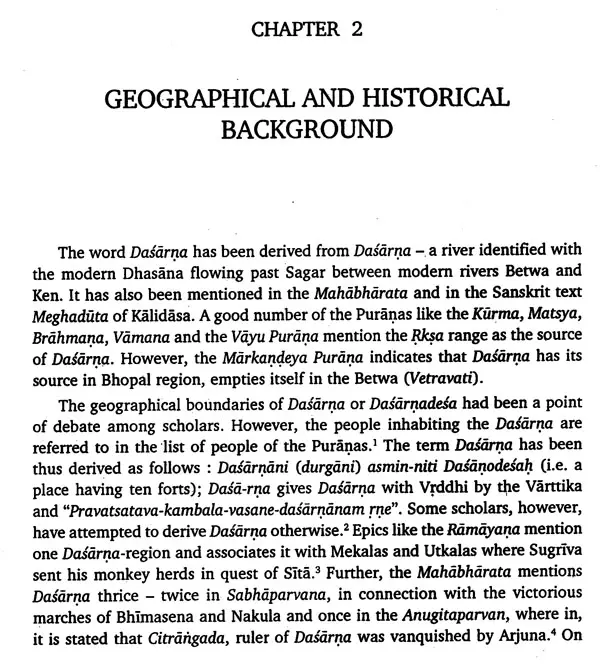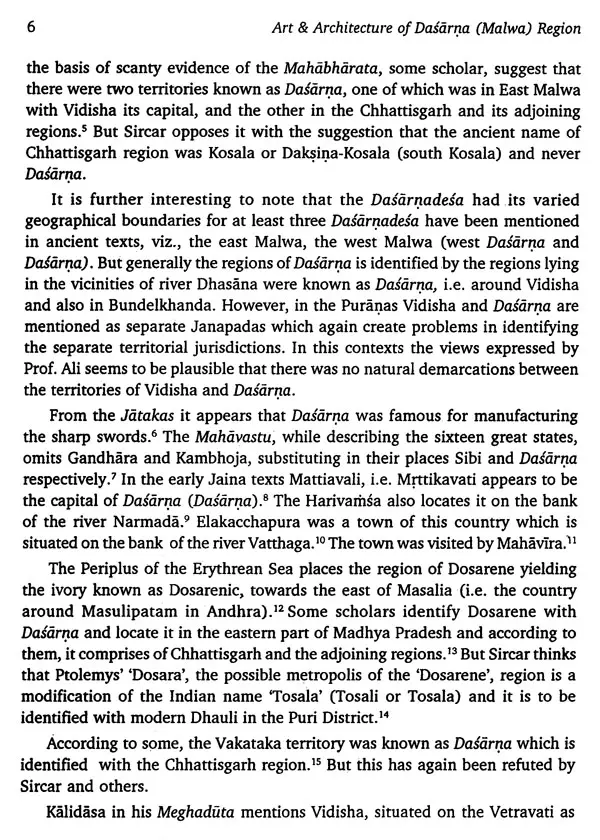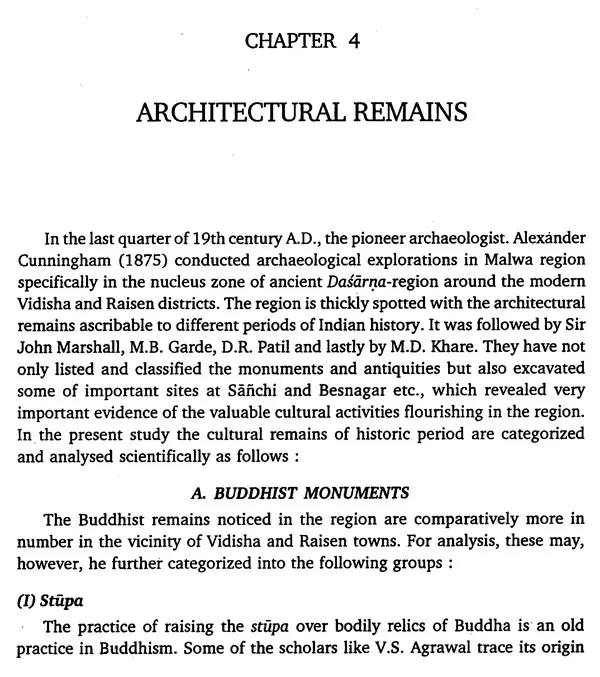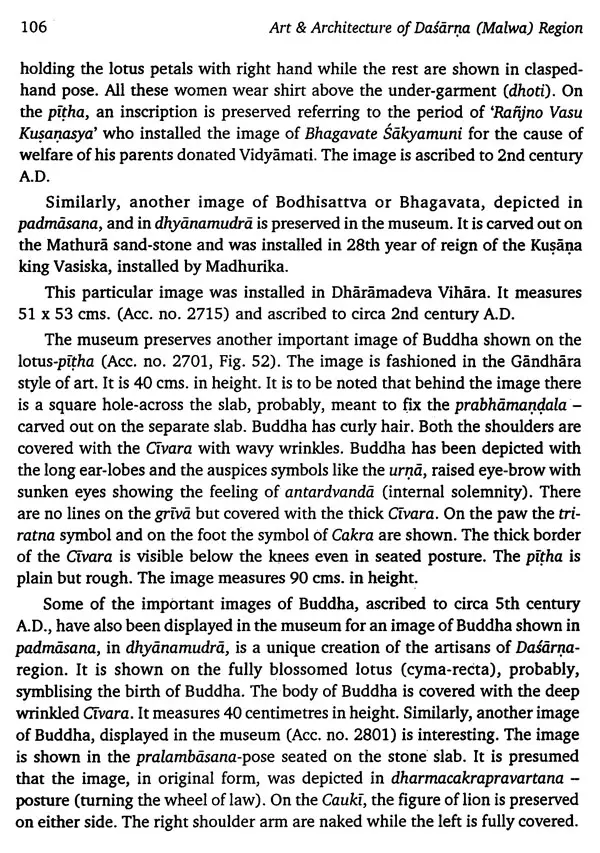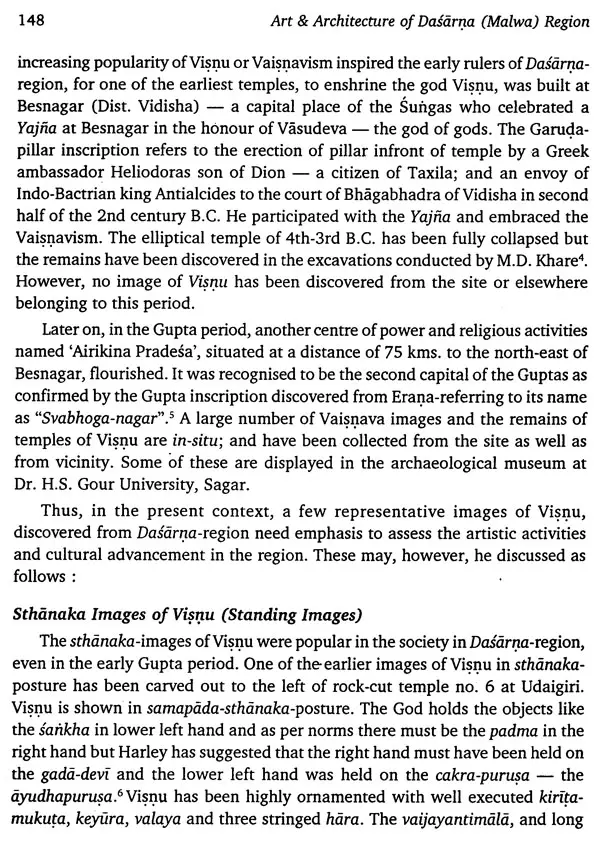
Art and Architecture of Dasarna (Malwa) Region
Book Specification
| Item Code: | UAE955 |
| Author: | Rahman Ali |
| Publisher: | Sharada Publishing House, Delhi |
| Language: | English |
| Edition: | 2008 |
| ISBN: | 9788188934546 |
| Pages: | 264 (Throughout B/W Illustrations) |
| Cover: | HARDCOVER |
| Other Details | 9.50 X 7.50 inch |
| Weight | 830 gm |
Book Description
The present book is a result of the comprehensive and scientific study of the ancient monuments of Dasarna-region (East Malwa). The author has surveyed scientifically the monuments of the area ascribed to the period ranging from circa 600 B.C. to 1300 A.D. The book contains the important geographical features and historical backdrops; glance of socio-economic and religious conditions which inspired and patronized the cultural activities in the Dasarnadesa; study of ancient monuments related with the major sects like the Buddhist, Hindu and Jaina noticed in-situ at different places of Dasarnadesa; study of the Hindu temples built during pre-Gupta, later-Gupta and medieval period, and the study of its defensive architecture and art of the raising monolithic pillars for religious purposes, e.g. Bhumija temple of Udayesvara (Dist. Vidisha) built by the Paramara rulers like Udayaditya. Further, the study of iconography of different divinities related with the Buddhist Jaina and Brahmanical (Saiva, Vaisnava, Sakta etc.) religions and the sculptures of the Yaksha and Yakshinis, which hold the unique position in Indian art heritage.
Dr. Rahman Ali, a well-known scholar of Fine Arts, History and Culture, was born in 1943, in a village of Dist. Gorakhpur (U.P.). After obtaining his Post-graduate Degree in Ancient Indian History, Culture and Archaeology from Gorakhpur University in 1965; he joined the advanced centre of archaeology-Deccan College Post-graduate and Research Institute, Pune; and obtained his Ph.D. Degree under the supervision of world renowned, Padma Bhusana, Prof. H.D. Sankalia, from Poona University in 1972.
He worked for higher research in the field with Prof. H.D. Sankalia for a period of more than a decade. While stay over at Deccan College, his academic interest was diversified; and later, he concentrated his higher research on the scientific study of the temple architecture of M.P. He successfully attempted to establish the methods of implementing the textual norms for analyzing the monuments and also the contemporary plastic arts of ancient India.
Thus, nearly dozen of books on the temple architecture of central India are in his credit. Besides the books on pre-history/proto-history, and more than 75 research papers, contributed to national and international journals. All these have helped him to bag the national and international awards from different academic bodies for his rare contribution. Apart from these, he has participated with several archaeological expeditions/ excavations undertaken by leading, scholars sponsored by the State Government and educational institutions. After joining Vikram University, Ujjain, he successfully conducted the archaeological explorations and excavations, besides several research projects. He has excavated the chalcolithic/historic sites and has published the detailed reports. More than 25 research scholars have been awarded Ph.D. Degree under the supervision of him. After achieving the age of superannuation, he retired from the post of Prof. & Head, S.S. in Ancient Indian History, Culture and Archaeology and still engaged in pursuing the research projects and many students are working under his supervision for their Ph.D. Research.
The recent trend of higher research in different branches of knowledge is more or less micro-based. In social science, the regional studies have thrown immense light upon the history and culture of India. The new data has been most interesting which compelled the scholars to reconsider their pre-established theories.
The present study of cultural contributions of Dasarnadesa (East Malwa) is a humble attempt to follow the recent trends. The evidenced data had been more fascinating which have been interpreted in a fresh way. The study has been concentrated on the ancient art and architecture of the region which flourished through the centuries.
A comprehensive scientific recording of the monuments and other cultural heritage have been assessed and are subjected to our critical study. The textual norm, epigraphic record, display of sculptures in the temples beside the lose sculptures etc. have been utilized for scientific interpretation of data. The important geographical situation of the region had been contributing immensely towards the history and culture of India through several centuries and it continued the cultural contacts for and wide.
In the present text the development of the stupa, vihara, monasteries and the Brahmanical templei etc. have, however, been traced in Dasarna-region, similarly, the plastic art of the country, i.e., beginning from free standing yaksa, and yaksi images to the classical icons of different Brahmanical divinities, the Buddhist and Jaina images etc., have been discussed which witness the regional features, extending its impacts over the other neighbouring regions in the later centuries.
It is interesting to mention that some of the rare sculptures of Yaksa, Yaksis of 1st century A.D. and the famous therianthropic and theriomorphic images, viz., Nr-Varaha and Varaha of Erana and Nr-Varaha of Udaigiri as well as the salabhanjika of Gyaraspur (Vidisha) etc., are the rare class of the sculptures in the whole range of Indian art.
As regards the ancient architecture, the world renowned stupa no. 1 at Sanchi, rock-cut cave temples at Udaigiri; and the classic temple of Udayesvara at Udaipur of early mediaeval period etc., have no parallel in the whole range of ancient Indian architecture. All these are the outcome of indigenous products of the artisans of Dasarnadesa (East Malwa).
Apart from these, the evidence of early defensive architecture, raising of the monolithic stone-pillars like one of the Asokas stone-pillar at Sanchi, Besnagar, Garuna Pillar of Heliodorus and the Dhbaja-sambhas at Erana etc., are the glorious. reminiscences of the high skill of art ever achieved by the artisans of Dasarnadesa. All these have been discussed in present text.
The author feels gratefulness to the authorities of Indian Council of Historical Research, New Delhi, for granting financial assistance without which it was not possible to complete the project. The author is highly indebted to Prof. Ram Rajesh Mishra, the Hon'ble Vice-Chancellor, for extending his kind co-operation and constant inspirations for higher study.
Our senior Prof. K.C. Jain, Dr. S.S. Nigam and other colleagues of the department had always been co-operating in clarifying my thoughts. My pupils like Dr. A.K. Dubey, Dr. N.K. Gideon, Dr. Roy C. Abraham and Dr. Ahmed Ali (Bhopal) etc., were sincerely co-operating me through out in the fieldwork; the author feels obliged to them. Apart from these, the other young research scholars like Shri Jitendra Kumar Chaudhary etc. at Vikram University, Ujjain, had always been sincerely helping the author for which they deserve special mention.
Prof. V.D. Jha, ex-Tagore Professor and Head, Dr. H.S. Gour University, Sagar (M.P.), provided the facilities to conduct fieldwork in Bundelkhanda and also permitted to study the collections in the university museum at Sagar, the author is obliged to him.
Shri R.K. Mathur, I.A.S., the Collector of District Vidisha (M.P.) and Dr. D.K. Mathur, Curator, District Museum at Vidisha (M.P.) extended their co-operations to study the rich collection in the museum. The author feels indebted to them.
Lastly, the author feels indebted to his beloved wife Dr. (Smt.) Wajiha Ali who had been inspiring constantly to complete the work. Her ever-ready help and suggestions had virtually been significant in completion of the research project.
I take great pleasure in writing foreword to "Art & Architecture of Dasarna (Malwa) Region" by Dr. Rahman Ali, Former Professor and Head, S.S. in Ancient Indian History, Culture and Archaeology, Vikram University, Ujjain, who has earned reputation of an eminent scholar.
Micro-study in all branches of learning has become highly productive and useful. Regional study of history and culture has acquired importance and has totally transformed old concepts/notions about India. Prof. Ali has conducted comprehensive fieldwork and interpreted the evidence of ancient cultural heritage scientifically.
This book is an integration of the two strands. This project was financed by the Indian Council of Historical Research, New Delhi. The work focuses light on the genesis and development of art and architecture in East Malwa which has played very significant role in cultural history of India.
I hope, this book would be up to the expectations of both the scholars as well as the common man.
The ancient Dasarnadesa (East Malwa) - the territory lying over the large north-east plateau of Malwa, was also known as Akara in circa 600 B.C. The people of this region have invariably contributed immensely towards the history and culture of India; and have been referred to in the literary texts like the epics, purana, Buddhist and Jaina literature in different contexts. The geographical situation of Dasarnadesa, is unique. The territorial boundaries had invariably been changing through the ages. Obviously, the people of the region were bound to play significant role in the political and cultural history of India.
In ancient period the major trade routes led from south across the region to the Gangetic plains. The modern town of Vidisha (ancient Besnagar) was then situated on the cross-roads from Sauvira in the west to Magadha in the east; and from Sravasti in the north to Pratisthana (Paithan) in the south.
It was due to the geographical location of Dasarnadesa, the towns like Vidisha gained more importance for trades; and also for the expansions of the political influence over the neighbouring regions. It attracted the attensions of the rulers of different dynasties and also the preachers of various religious sects.
A good number of cultural remains, in the shape of sculpture, monument, inscription and coins etc., discovered from the region, witness to the glorious past of Dasarna-region. Infact, Cunningham's Tour Reports (23 vols.); Sir John Marshall's - The Monuments of Sanchi (3 vols., Oxford, 1940); M.B. Garde's Annual Administration Report, Archaeological Department, Gwalior etc. had been the guidelines for the further studies of monuments. It inspired us to take up the project on Dasarna-region. Therefore, we have made an attempt to analyse the monuments and other remains on the basis of textual prescriptions.
The study of monuments and sculptures, those in-situ and also preserved in the museum, have been brought together and subjected to a critical study. Besides religious architecture, we have focussed light upon the defensive architecture and also the development of civil architecture in the region. For fresh analysis the ancient Sanskrit texts have been utilized for the norms prescribed by the Brhatsamhita, Purana, Samarangana-Sutradhara and the Aparajitaprasnaprccha etc. have been used.
A comprehensive survey of the monuments of Dasarna-region has been done. For fresh interpretations a comprehensive photography has been done and the sculptures intact with the original monuments and those preserved in the museums have been brought together and subjected to a critical study.
Thus, the problem has been critically discussed in the present text into ten chapters as follows: After brief introduction, second chapter is devoted on the brief geographical and historical back-drop of the region. It follows the third chapter which gives a glance of the socio-economic and religious conditions of Dasarna-region during ancient period. The fourth chapter is comparatively comprehensive which is devoted to deal with the Buddhist and Jaina monuments of the region. It is divided into several sub-heads like - the stupa, caitya, temple and monasteries.
Likewise, fifth chapter is more comprehensive and important which is devoted on dealng with the analysis of architectural features of the Hindu temples - beginning with the rock-cut cave temples to the classical structural temples. It is further added with the study of defensive and civil architecture of the region. The important sites like Besnagar, Sanchi, Erana, Badoh-Pathari, Vidisha, Gyaraspur and Udaipur etc. have been scientifically surveyed. Most of the monuments are situated in the close vicinity of the Vidisha region, hence, it may be a nuclear zone for cultural activities.
Sixth chapter is devoted to deal with the development6 of Buddhist and Jaina iconography. A good number of Buddhist and Jaina Sculptures have been discovered from Dasarna-region. It includes the images of Bodhisattva, Avalokitesvara and the Jaina sculptures of Tirthankara, Yaksa and Yaksinis. These evidence prove that both the sects flourished in the region.
Seventh chapter is devoted on the Brahmanical iconography' dealing with the icons of Siva and his family members like Ganesa and Karttikeya.
The image of Visnu and his incarnations have been discussed in eighth chapter, while the images of Brahma, Astadikpalas and Navagrahas have been discussed in nineth chapter.
The iconography of Sakti's images have been discussed in the tenth chapter. The images of Sarasvati, Mahisasurmardini, Gaja-Laksmi, Sapta-Matrkas and Yogini have been analysed critically based on the textual norms.
It is noteworthy that for the first time an attempt has been made to study the art and architecture of Dasarna-region based on textual prescriptions. The interpretations have been authenticated by a number of illustrations. Thus, the contribution of Silpis and the people towards art and architecture of the region and India as whole have been assessed. It is expected that the work will help the scholars and common man to understand the cultural history of Dasarnadesa particular; and India as a whole.
**Contents and Sample Pages**
